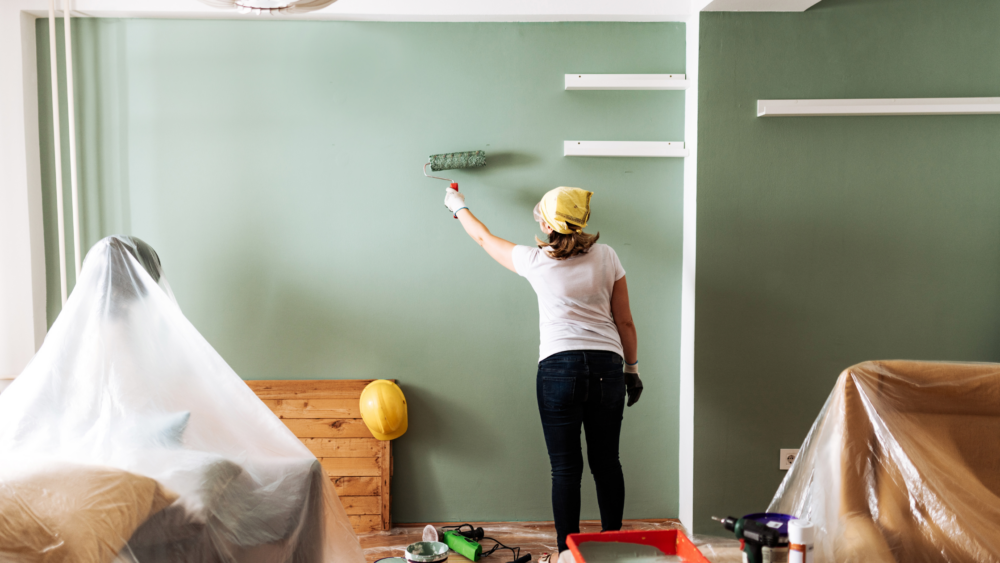Ever dreamt of transforming your humble abode into a lavish haven? Like turning that cramped kitchen into an inviting open space or revamping the dated bathroom?
I bet you have. But let’s face it, such dreams often come with hefty price tags.
Many others face the same issue. Millions grapple with the same question: How to fund their home remodeling projects without breaking the bank?
This is where home remodeling loans stride in, like knights on white horses, offering financial help for those grand designs.
But hold up! Navigating through loan rates can be as confusing as assembling a 1000-piece jigsaw puzzle blindfolded!
Are you hooked? Great! Stay with us. We’re about to shed light on everything, from different loan types to how you can snag the best rates. Trust us, this is going to be enlightening!
Understanding Home Remodeling Loans
Home remodeling loans are a lifeline for homeowners who want to spruce up their homes but don’t have the cash at hand. These loans provide a way to access money for home improvement tasks, like giving your kitchen a facelift or putting in an extra room.
A big advantage of these loans is that they often come with lower interest rates compared to credit cards. This makes them a more affordable way to fund your renovation project. Plus, depending on the loan type and usage, it’s possible that the interest may even be eligible for tax deductions.
Different types of home remodeling loans are available to suit different needs and circumstances. Some popular ones include personal loans, home equity loans, and government-backed Title I Property Improvement Loans. Your choice will depend on factors like how much money you need, what kind of improvements you’re planning, and your financial situation.
The Process Simplified
The process starts with figuring out how much work is needed in your house and estimating its cost – getting quotes from contractors can help here. Once this step is complete, start shopping around for lenders offering competitive rates.
To apply for a loan: submit an application detailing why do you need this loan? What changes are planned? It’s also necessary at this point in time show proof income along evidence good credit score if possible. After approval funds usually get disbursed directly into account which allows pay contractor without any delay.
Remember, like all loans, you’ll need to pay back a home remodeling loan with interest. Once you’ve secured the funds, it’s essential to plan out how you’ll manage your loan repayments.
Why Consider Home Remodeling Loans?
Not only do renovations spruce up your home’s look and tackle any practical problems, but they can also significantly increase your property value.
Types of Home Remodeling Loans
Revitalizing your property with home remodeling projects can be expensive, yet homeowners have various loan options to help fund these costs. To help cover these costs, homeowners have several loan options available to them.
Personal Loans
A personal loan is a versatile option that lets you borrow funds for almost any purpose, including home improvements. They’re typically unsecured, meaning you don’t need to put up your home as collateral. The Consumer Financial Protection Bureau notes that this might be a good fit if you want the flexibility and are confident in your ability to repay within the agreed term.
Home Equity Loans
Home equity loans, also known as second mortgages let homeowners borrow against their property’s value minus what they owe on it (Investopedia). The upside? Interest rates tend to be lower than those for personal loans because it’s secured by your house itself. But remember – default could mean losing your beloved abode.
Goverment-backed loans
If traditional lending doesn’t appeal or apply to you – fret not. Government programs like FHA 203(k) and Title I Property Improvement loans give folks access to funds specifically for fixing up their homes (Source: HUD.gov). These types of renovation financing options are often more accessible, even if your credit score isn’t perfect. Nonetheless, these come with their own particular rules and limitations.
So there you have it – a toolbox full of loan types to help bring your remodeling dreams into reality. Each one comes with its own pros and cons that need careful consideration. After all, picking the right tool for the job can make all the difference between a renovation dream and nightmare.
Factors Influencing Loan Rates
Your credit score, loan amount, and the term of your loan can significantly influence home remodeling loan rates. Let’s examine how these factors can affect the rate.
Credit Score: The Key to Unlock Better Rates
A higher credit score typically leads to lower interest rates. Lenders see borrowers with high scores as less risky, so they’re more likely to offer competitive rates.
If you’ve got an excellent credit rating (720 or above), you’ll be in a better position when it comes time to negotiate your rate. But if your score is on the low side, don’t despair – there are ways you can boost it before applying for a loan.
The Influence of Your Loan Amount
The size of your renovation project—and thus the amount needed—can impact the rate offered by lenders. Larger loans often have higher interest because they pose more risk for lenders. Conversely, smaller projects might let you get away with borrowing less and snagging a better rate as well.
The Impact of Your Loan Term
The length—or term—of your home improvement loan also affects its cost. Longer terms generally come with lower monthly payments but higher overall costs due to longer periods of accruing interest. Shorter terms mean bigger monthly payments but could save money in total interest over time.
The Lender’s Perspective
Lenders aren’t all created equal, and neither are their loan offerings. Different institutions may offer varying rates for the same borrower profile due to their unique lending criteria or risk assessments.
Market Conditions
Lastly, don’t forget that general market conditions, such as inflation rates and Federal Reserve policies, have a say in home remodeling loan rates. By keeping tabs on these economic indicators, you can navigate the financial landscape more effectively.
How to Compare Home Remodeling Loan Rates
Comparing home remodeling loan rates might feel like trying to find the perfect piece of furniture in a vast warehouse. But don’t worry, we’ve got your back. Let’s start by understanding what affects these rates.
The Role of Credit Score
Your credit score is like a report card for lenders. A higher score can lead to lower interest rates because it signals less risk for the lender. So, before you dive into comparing loans, make sure you’re aware of where your credit stands.
Type and Term of Loan
Different types of loans have different rate structures. For instance, home equity loans typically offer fixed rates, while personal loan rates may vary. The term length also plays its part; longer terms usually come with higher total costs but smaller monthly payments.
Shop Around – Comparisons are Key.
Gather quotes from various lenders just as if you were shopping around for that unique coffee table. Comparing the APR, which combines interest rate and fees, of different lenders is essential for finding the best deal. Research shows that borrowers who shop around save more money over time.
- Lender Reputation: Make sure to consider each lender’s reputation too. Look at customer reviews or ask friends about their experiences – remember quality matters not only when picking out tile but choosing lenders too.
- Online Tools: Use online comparison tools to make this process easier. They can give you a snapshot of different loan offerings side by side, simplifying the decision-making process.
Negotiation – It’s Not Just for Car Buying
Don’t be shy about negotiating with lenders. You may be surprised at how flexible some might be on their rates or terms, especially if you have a strong credit score or stable income. It’s worth inquiring – you may be pleasantly surprised.
essentially about weighing up your options for financing a home makeover. It’s important to thoroughly review the terms and rates offered by different lenders, ensuring you get the best deal possible.
Tips for Securing a Favorable Loan Rate
Getting a favorable loan rate can feel like trying to find a needle in the haystack. But, there are strategies that can help you land on an interest rate that won’t break your budget.
Boost Your Credit Score
Your credit score plays a significant role in determining your loan rates. Higher scores usually mean lower rates because lenders see less risk involved. So, before applying for any boosting your credit score, take steps to improve it.
Pick the Right Loan Term
The term of your home remodeling loan is another factor to consider when looking for better rates. Shorter-term loans often have lower interest rates but higher monthly payments than longer-term loans.
Shop Around and Compare Rates
Different lenders offer different terms and conditions which means they also provide varying loan rates. Don’t just stick with one lender; take some time to shop around, compare offers from various banks or lending institutions so you’ll get the best deal possible.
Consider Adjustable-Rate Loans
If you’re planning on paying off your renovation quickly, adjustable-rate mortgages (ARMs) could be worth considering as they typically start with low-interest rates during their initial fixed period (source: BankRate ARM vs Fixed Calculator). Just make sure it’s within a timeframe where no dramatic increase will happen after adjustment periods kick in.
Make a Larger Down Payment
If you can afford it, making a larger down payment could also help lower your loan rate. Lenders often see borrowers who make substantial down payments as less risky and therefore offer them better rates.
Negotiate Your Rate
Believe it or not, everything’s negotiable – even your loan interest rate. Don’t be scared to request a reduction; the most pessimistic outcome is that they’ll say no.
Don’t forget, getting a good deal on home remodeling is important. Make sure you’re always on the lookout for the best opportunities.
Potential Risks and Drawbacks of Home Remodeling Loans
Just like any financial decision, home remodeling loans come with their own set of potential risks and drawbacks. But don’t worry, we’re here to shed some light on them so you can make an informed choice.
The first thing that might give you pause is the risk of over-improvement. This happens when your renovations are more expensive than what your neighborhood’s market value can support. Transforming your kitchen into a master chef’s haven may not necessarily result in the kind of value boost you anticipated.
Falling Into Debt
Another possible drawback is falling into debt. Yes, these loans let us turn our homes into better living spaces but remember – they need to be paid back. Borrowers who aren’t careful may find themselves in a cycle where they’re always borrowing money for projects around the house.
Higher Interest Rates
Beware too of higher interest rates compared to other types of loans such as mortgages or student loans. Higher interest rates mean larger monthly payments which could stretch out your budget thin.
Risk Of Foreclosure
A scarier risk associated with certain types like Home Equity Loans or HELOCs (Home Equity Line Of Credit) is foreclosure. Since these loan types use your house as collateral, failing to repay means losing your precious abode.
- If approved for more funds than needed for the renovation project: resist temptation. Stick strictly to budget plans to avoid unnecessary debt.
- Shop around for the best interest rates and terms before settling on a loan offer. Different lenders may give varying offers, so make sure you get the best deal possible.
This information isn’t meant to scare you off, but rather to ensure that you are aware of potential pitfalls when considering home remodeling loans. Making an informed decision will help your renovation project run smoother and be more successful in the long term.
Alternatives to Home Remodeling Loans
If a home remodeling loan isn’t quite your style, don’t fret. There are other options that can help fund your renovation project without the need for such loans.
Savings
The most straightforward alternative is using your savings. If you have been prudent enough to build up a financial cushion, this could be an ideal moment to draw on it. This method lets you avoid any interest charges entirely, which means more money stays in your pocket.
But before dipping into those funds, make sure it doesn’t jeopardize your financial security or retirement plans. Learn more about strategic saving here.
Credit Cards
You could also consider funding smaller projects with credit cards – but tread carefully. While some offer introductory 0% APR periods (see our top picks), remember these rates won’t last forever.
Paying off the balance before the higher interest rate kicks in will save you from mounting debt. But if managed well, they can give flexibility and even rewards points on certain purchases.
Contractor Financing
Last but not least: contractor financing – when the company doing renovations offers to finance the project themselves. It’s like getting two birds with one stone – organizing both work and payment through one source. Check out this guide on contractor financing.
However, make sure to compare the offered rates with other available options. Sometimes these arrangements may not be cost-effective over the long haul.
In essence, each alternative has its pros and cons. Your choice should depend on your financial situation, project size and comfort level with debt. Explore all avenues before deciding – it’s not just about getting that dream kitchen or bathroom but doing so responsibly.
FAQs in Relation to Home Remodeling Loans Rate
Are renovation loans a good idea?
Renovation loans can be a great choice if you need to make major home improvements but don’t have the cash on hand.
What credit score do you need for remodeling?
A decent credit score, typically 620 or higher, is needed to qualify for most home remodeling loans.
What is the downside to a home equity loan?
The biggest drawback of a home equity loan is that your house serves as collateral. If you fail to repay, you risk losing it.
What is the largest home renovation loan?
The Federal Housing Administration’s 203(k) program provides one of the highest limits for renovation loans – up to $625k in high-cost areas.
Conclusion
So, you’ve made it! Now, the home remodeling loans rate shouldn’t seem like a daunting maze anymore.
We started by understanding what home remodeling loans are. We dug into different types of these loans and explored how rates can vary based on factors such as credit score and loan term.
We gave you practical tips to compare loan rates effectively. We offered advice to help secure a favorable rate for your dream renovation project.
But we didn’t stop there. Aware that every silver lining has its cloud, we discussed potential risks and drawbacks too.
Finally, in case you decided this isn’t for you after all, we even looked at alternatives!
The road to achieving your dream home might be bumpy but remember: equipped with knowledge about home remodeling loans rate – the journey just got smoother! If you’re looking forward to renovating your home, CostGuide.com has got you covered! With localized cost guides tailored for homeowners like yourself, we aim to simplify how renovations are done.




